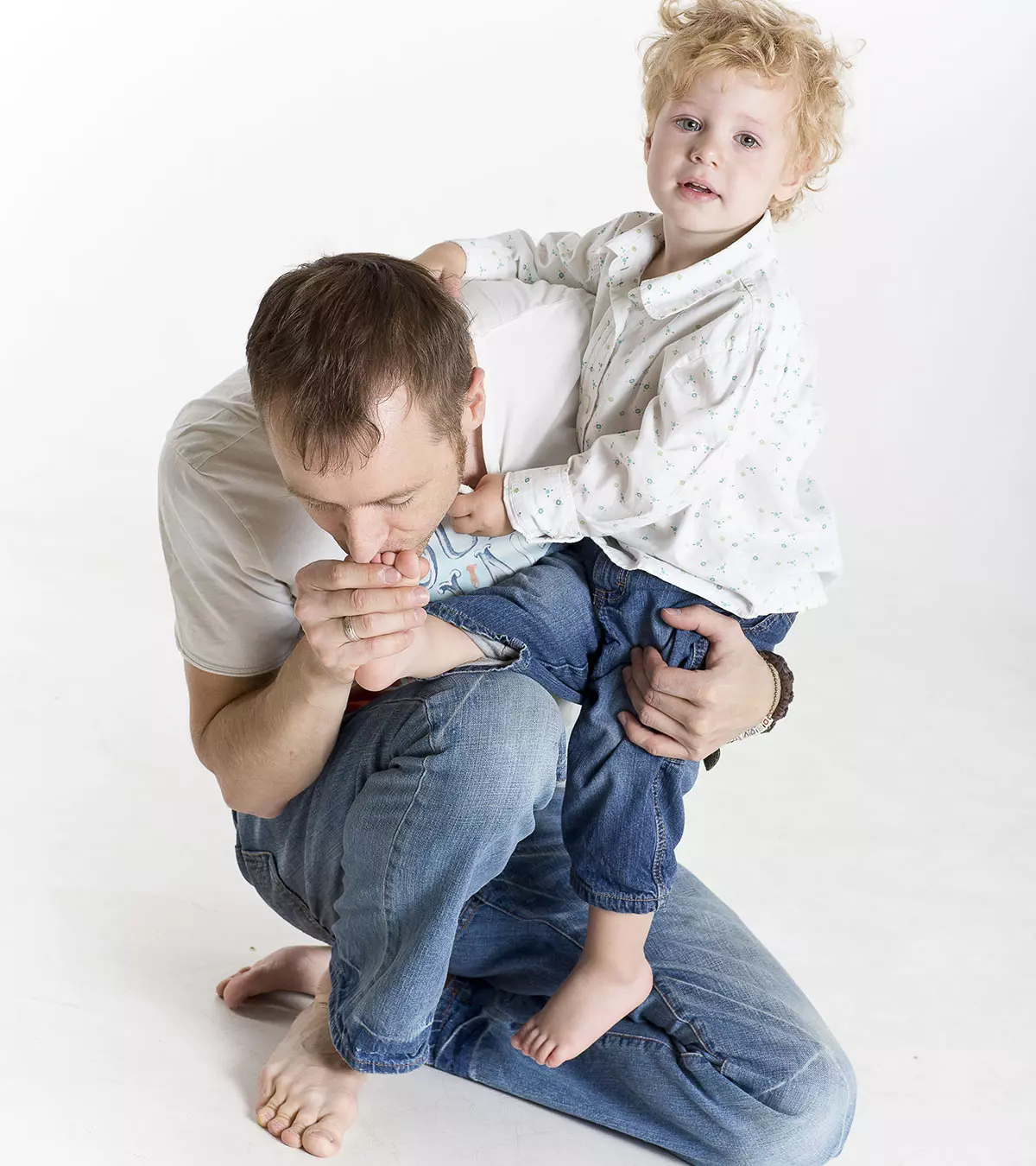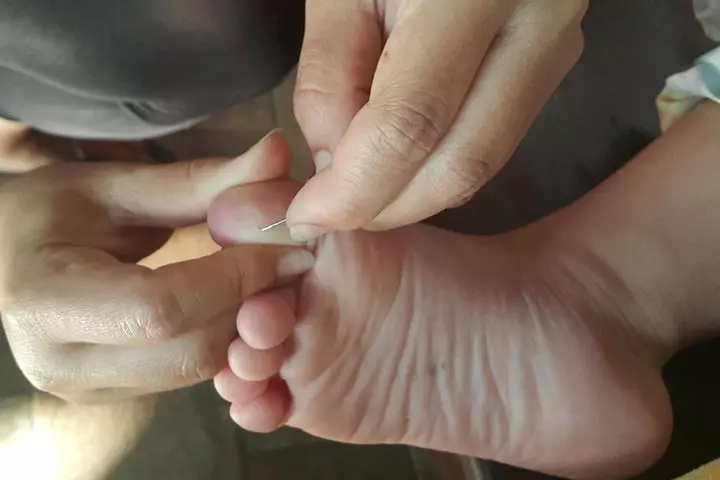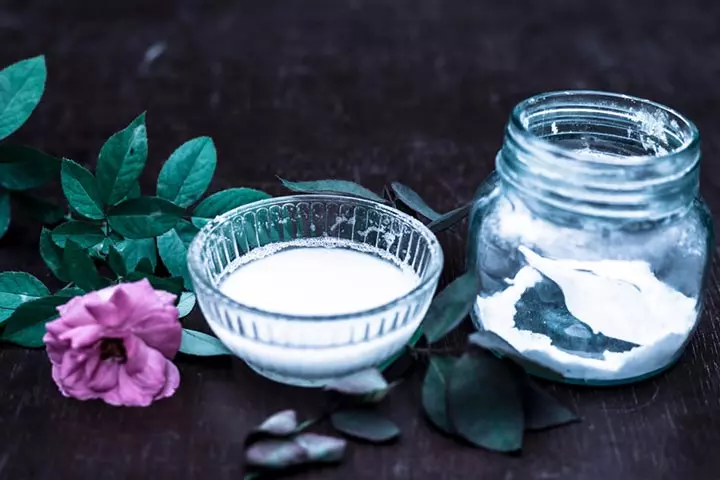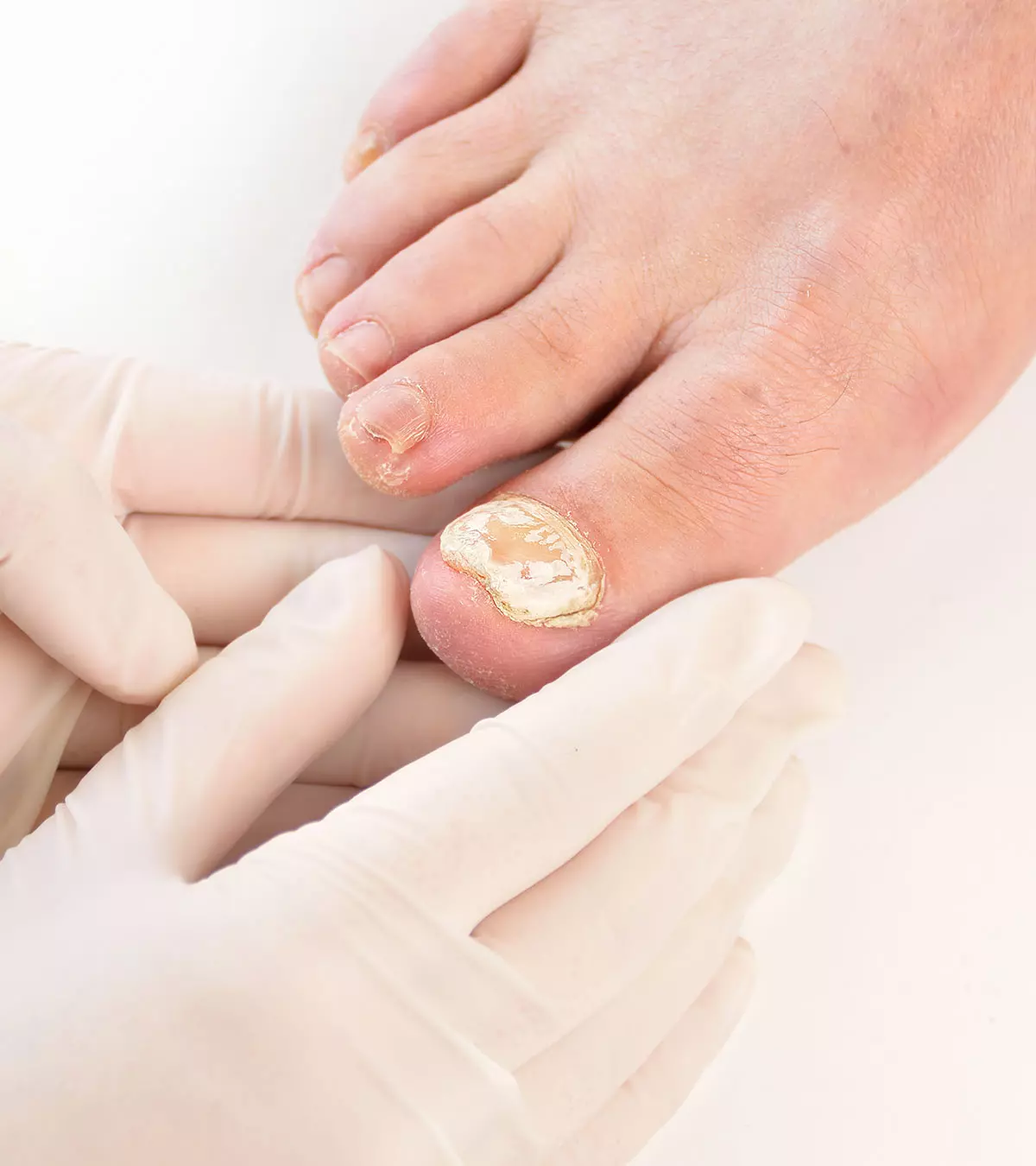
Image: Shutterstock
Toddlers love to jump around the house, and nothing can stop them. Not to forget, they love to run around barefoot. This increases the risk of them encountering a splinter, making you eventually wonder how to remove it from your toddler’s foot.
A splinter is a fragment of any object that gets lodged inside the tissues of the feet unintentionally (1). Splinters are usually harmless and can be removed easily with the help of a tweezer, except when they penetrate deep into the skin, increasing the chances of an infection. In such cases, consult the doctor immediately. Read on to learn how you can easily remove a splinter from your child’s feet.
Key Pointers
- Splinters can be removed with tweezers, but medical attention should be sought if they are deep and may cause infection.
- To remove a splinter at home, one should wash their hands and the affected area, sterilize their tools, pull out the splinter, and apply antibiotics and a bandage.
- Other methods for removing splinters include using cello tape, glue, and baking soda paste.
- If the splinter causes redness, swelling, and pus or if a toddler is not up to date with vaccinations, a doctor should be consulted.
- Toddlers should be encouraged to wear shoes while running and jumping to avoid getting splinters.
Steps To Remove A Splinter From The Toddler’s Foot
So, your little walker got a splinter, now what? Don’t worry. Splinters in toddlers are common and mostly harmless unless they get impacted or infected. In fact, you can easily remove a small splinter at home. Here’s what you need to do (2):
Step 1: Stay calm. Your little one needs you to stay calm, as they’re likely scared already. A squirming toddler makes first aid difficult. Before you begin, gather your supplies, such as tweezers, a sterilized needle (if needed), antibiotic ointment, and a bandage. Having everything ready will make the process smoother and less stressful for both you and your child.
Step 2: Wash your hands thoroughly with soap and your toddler’s foot (or hands, wherever the splinter has found its way). The last thing you need is an infection.
Step 3: Get help. No matter how much you explain, chances are your toddler will squirm when you try to remove the splinter. So, ask another adult to help keep the toddler quiet and keep the foot steady.
Step 4: Bring out your tweezers and disinfect them preferably with spirit. Now grab the part of the splinter that is visible and pull it out.
Step 5: If the splinter is not visible and has dug deep, you’ll need a needle. The needle should undergo sterilization before you make a small hole in the skin. Use the needle to lift out the splinter a bit. Now you can remove it with tweezers.

Step 6: Finally, apply some antibiotic cream on the area and tie a bandage. This will prevent any infection.
 Quick tip
Quick tipAn anonymous mother and blogger recounts how, after several attempts, she finally removed a splinter from her son Adam’s foot. She writes, “I took the needle and carefully scraped the skin over the splinter. When I had the area open and could get to the splinter with my tweezers, I just pulled it out. I put Polysporin over the area and covered it with a band-aid. Once Adam understood that this wasn’t going to take forever and I figured out the optimal way to remove the splinters, it wasn’t that bad. The trick was to soak the skin; that made things much easier and less intrusive. I’m glad these are out (i).”
Alternate Ways Of Removing Splinters From Toddler’s Foot
If tweezers are not your cup of tea, or if your toddler is not letting you come near with a pair, you’ll need alternate methods for extraction of the splinter.
If you’re looking for effective ways to remove splinter from a child’s skin, these home remedies can help ensure the splinter is safely and gently removed.
1. Cello tape
Get a piece of cello tape and put it over the tip of the splinter in the wound. Now pull out the tape. The splinter will stick to the adhesive tape and come out. This is a ‘no tear’ solution for removing splinters!
2. Glue
You can also use glue to remove a splinter from your toddler’s skin. Put the glue on the affected area, allow it to dry and simply peel it out, along with the splinter!
3. Baking soda

If you cannot even see the splinter, baking soda may well be the solution for you! Mix baking soda and water to make a thick paste. Now, smear the paste on a bandage and put over the affected area. Leave for 24 hours. Once you remove the bandage, the splinter should now be visible. You can simply remove it with a pair of tweezers. If it is still not visible, repeat the process for another 24 hours.
 Quick tip
Quick tip4. Salve ointment
A salve (a topical ointment) is considered helpful for removing splinters or other foreign objects. It softens the skin around the splinter, facilitating the body’s natural process of pushing out the foreign item. The salve speeds up this process by moisturizing the area and incorporating anti-inflammatory ingredients, promoting healing before the incision closes. In addition, it increases blood flow, which aids in pus production. As the pus drains, it carries the foreign item with it.
Apply small amounts of salve to the affected area and gently massage it; the area may feel slightly sore. Leaving it on overnight can be effective; often, just one application is sufficient to remove splinters.
Most splinters are harmless and ease out without causing much harm, bleeding, or pain. However, there are rare cases of infection that you should be aware of. If you’re unsure about symptoms or possible complications, it’s best to consult a doctor.
When To See Your Doctor?

 Experts say
Experts sayIf you are up to date with your toddler’s vaccination, splinters are not a cause for panic. The Centers for Disease Control and Prevention (CDC) recommends that children receive the routine DTaP (Diphtheria, Tetanus, and Pertussis) vaccine before the age of seven (4). According to a CDC report, between 2016 and 2019, 80.4% of children received all four doses of the Diphtheria, Tetanus, and Pertussis vaccine by the age of 24 months. But if you have missed a dose or two, there is a slim chance of tetanus, a dangerous infection that can even be fatal. So, make sure your child’s schedule is on track. To be careful, it is better to give a tetanus shot if the doctor suggests it (5).
The other thing to look out for is infection. If you notice swelling, irritation, redness and pus; go to your pediatrician. These are all classic symptoms of infection and need medical intervention. The infection can develop into an abscess.
The graph below represents the number of new tetanus infection cases in different parts of the world. The majority of new cases are seen to occur in South Asia and Sub-Saharan Africa, accounting for about 82% of all tetanus cases globally. South Asia may have more cases of tetanus than other regions, but a 14-fold fall in the incidence rate has been achieved in just three decades, which indicates a positive development.

The global incidence of new tetanus infections (2015-2019)
Source: Tetanus; Our World in Data/ United States: Institute for Health Metrics and Evaluation (IHME) Quick fact
Quick factTips To Prevent Splinters In Your Toddler’s Foot

This is one saying that never grows old! Why put your toddler through tears and screams when you can prevent it? All you need to do is follow some simple steps:
- Encourage your toddler to keep their shoes on. Easier said than done! But it is the simplest way to prevent splinters.
- While playing outdoors, check the swings and slides (and other ‘fun’ places). These are the places that are most likely to splinter off.
- Keep a check on your home furniture and wooden toys to keep them in good condition and avoid splinters from rough surfaces.
- If your toddler likes running or playing outside, choose soft, grassy, or padded surfaces instead of rough, wooden ones.
- Teach your toddler to recognize unsafe items, such as sharp glass or rough wooden toys.
- After outdoor play, check your toddler’s feet for debris or splinters to prevent further injury and complications (6).
Frequently Asked Questions
1. How do I get a splinter out of a toddler’s foot with a syringe?
If you don’t have tweezers or are unsure how to remove splinters from your toddler’s foot, an empty syringe can help. If you can see the tip of the splinters, place the syringe above it, ensuring it is touching the skin and there is no gap, and then pull the syringe out. The vacuum pressure built into the syringe may help you remove a splinter from the foot. However, use a clean syringe to avoid infection or contamination.
2. How does Epsom salt draw out splinters from a toddler’s foot?
Epsom salt generates pressure, which can bring the foreign object or materials to the surface. Soak the affected area in Epsom salt water for 10 minutes or longer, as needed (3).
3. Will vinegar draw out a splinter from my toddler’s foot?
Yes. Due to its acidic nature, vinegar may help remove the splinter from the toddler’s foot by shrinking the surrounding skin around the splinter. Under pediatric guidance, you may gently apply it to your toddler’s skin by pressing cotton soaked in vinegar against it; however, be careful that your toddler does not consume it in any way.
4. What should I do after removing the splinter?
After removing the splinter from your toddler’s foot, clean the area and apply antibiotic ointment like Polysporin. Contact your child’s doctor if you feel the splinter wasn’t fully removed, if your child still feels pain, or if you notice signs of infection (3).
Splinters are painful, but they aren’t reason enough to cocoon your toddler. Allow them to explore instead, and if a splinter does get into your toddler’s skin, try to tweeze it out. If your toddler doesn’t let you touch, you may try using cello tape, glue, or baking soda to remove a splinter from their foot. If the splinter becomes infected or becomes deeply embedded, and you observe swelling, consult your child’s doctor. Also, encourage your children to wear shoes when playing outside to reduce the risk of splinters.
Infographic: Alternate Ways Of Removing Splinters From Toddler’s Foot
You may try several methods to remove a splinter from your toddler’s foot. The following infographic provides a list of possible options, along with tips on how to prevent splinters from occurring. If you are unable to remove the splinter or observe signs of infection, such as redness, swelling, or pus, it is vital to seek medical attention from your child’s healthcare provider. Illustration: Momjunction Design Team
Having a splinter can be a painful and uncomfortable experience. Learn how to safely remove it and when to seek help in this informative video!
Personal Experience: Source
MomJunction articles include first-hand experiences to provide you with better insights through real-life narratives. Here are the sources of personal accounts referenced in this article.
i. Splinter removal;
https://oneofthosememories.wordpress.com/tag/splinter-removal/
References
- Splinters.
https://www.stanfordchildrens.org/en/topic/default?id=splinters-90-P02851 - Splinters.
https://www.cincinnatichildrens.org/health/s/splinters - How To Remove a Splinter — and When to Call Your Doctor.
https://health.clevelandclinic.org/how-to-remove-a-splinter-and-when-to-call-the-doctor/ - Tetanus Vaccine Recommendations.
https://www.cdc.gov/tetanus/hcp/vaccine-recommendations/index.html#:~:text= - Immunization.
https://www.cdc.gov/nchs/fastats/immunize.htm#:~:text= - How to Handle a Splinter.
https://kidshealth.org/en/parents/splinters-sheet.html? - Splinters and Other Foreign Bodies in the Skin.
https://www.healthychildren.org/English/health-issues/conditions/skin/Pages/Splinters-and-Other-Foreign-Bodies-in-the-Skin.aspx
Community Experiences
Join the conversation and become a part of our nurturing community! Share your stories, experiences, and insights to connect with fellow parents.
Read full bio of Dr. Mubina Agboatwalla
Read full bio of Rohit Garoo
Read full bio of Dr. Ritika Shah
Read full bio of Shinta Liz Sunny



















